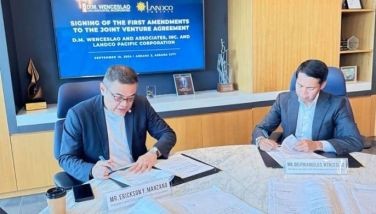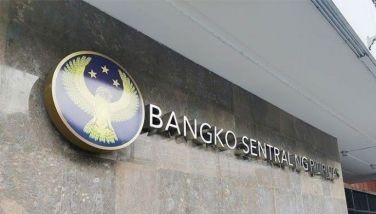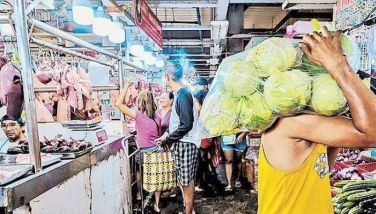Rice importation results in P23.5-B losses for government
April 8, 2002 | 12:00am
Government has lost up to P23.526 billion in foregone revenue from rice importation and spent P1.5 billion on price intervention every year since 1995 but domestic rice prices are still the highest in Asia despite cheap imports and price subsidies.
Because of wrong policies, costly subsidies and weak governance, experts warn that the country’s chronically ill agriculture sector, particularly rice, would be ripe for a collapse if the government does not bite the bullet and implement reforms that are necessary, even if unpopular.
According to V. Bruce J. Tolentino, professor at Ateneo de Manila University’s School of Government, the total cost of the national rice price interventions include not just direct allocations from the national budget but other components that are not being calculated but are still being paid for by the economy as a whole.
In 1998, for instance, when the country imported over two million tons of rice, the government lost about P11 billion in foregone tariff revenue. However, the cost of this importation also included P1.3 billion in general appropriations subsidies and equity to the National Food Authority; P4.9 billion in borrowing from commercial banks by the NFA and about P9 billion in estimated welfare loss to farmers and consumers.
"The NFA has a costly and impossible mission," Tolentino said. "The current rice price policy is expensive and it does not work."
Aside from the fact that farmers have not received better prices for the country’s most political agriculture commodity, Tolentino said that only about 65,000 out of two million rice farmers actually had access to the NFA’s procurement program.
The way government has approached agricultural development, Tolentino said, achieved exactly the opposite of its objectives and led to the steady increase in importation as a percentage of total production which itself is not growing fast enough to cope with population growth.
In rice, for example, imports were 1.13 percent of total supply in 1975-1979 going up to 1.73 percent in 1980-1989 before jumping to 7.31 percent in 1990-1999 and to eight percent of total supply in 2000-2001.
Despite the government’s price intervention program, Tolentino said Philippine rice is still two to three times more expensive than Thai and Vietnamese rice. Because of inadequate public spending on agricultural facilities, Tolentino said price intervention is not working because the actual cost of production is not improving.
The cost of paddy production in Central Luzon, Philippines was estimated by the International Rice Research Institute at P34,701 per hectare in 1999 compared with only P24,859 per hectare in Central Plain, Thailand; P26,712 per hectare in Mekong Delta, Vietnam and P26,197 per hectare in West Java, Indonesia.
Although the solutions were obvious even to the most obstinate policy makers, Tolentino said reform efforts are being constrained by discontinuity and excessive attention to short-term political aspects in decision-making.
Tolentino said government would have to renew its focus on farm productivity while removing NFA’s monopoly on imports by encouraging broad participation in rice trade.
Tolentino also said that the government should capture revenues from rice importation and use this to finance productivity measures. "NFA support should be aimed at the very poor and for emergency reserves," he said. – Des Ferriols
Because of wrong policies, costly subsidies and weak governance, experts warn that the country’s chronically ill agriculture sector, particularly rice, would be ripe for a collapse if the government does not bite the bullet and implement reforms that are necessary, even if unpopular.
According to V. Bruce J. Tolentino, professor at Ateneo de Manila University’s School of Government, the total cost of the national rice price interventions include not just direct allocations from the national budget but other components that are not being calculated but are still being paid for by the economy as a whole.
In 1998, for instance, when the country imported over two million tons of rice, the government lost about P11 billion in foregone tariff revenue. However, the cost of this importation also included P1.3 billion in general appropriations subsidies and equity to the National Food Authority; P4.9 billion in borrowing from commercial banks by the NFA and about P9 billion in estimated welfare loss to farmers and consumers.
"The NFA has a costly and impossible mission," Tolentino said. "The current rice price policy is expensive and it does not work."
Aside from the fact that farmers have not received better prices for the country’s most political agriculture commodity, Tolentino said that only about 65,000 out of two million rice farmers actually had access to the NFA’s procurement program.
The way government has approached agricultural development, Tolentino said, achieved exactly the opposite of its objectives and led to the steady increase in importation as a percentage of total production which itself is not growing fast enough to cope with population growth.
In rice, for example, imports were 1.13 percent of total supply in 1975-1979 going up to 1.73 percent in 1980-1989 before jumping to 7.31 percent in 1990-1999 and to eight percent of total supply in 2000-2001.
Despite the government’s price intervention program, Tolentino said Philippine rice is still two to three times more expensive than Thai and Vietnamese rice. Because of inadequate public spending on agricultural facilities, Tolentino said price intervention is not working because the actual cost of production is not improving.
The cost of paddy production in Central Luzon, Philippines was estimated by the International Rice Research Institute at P34,701 per hectare in 1999 compared with only P24,859 per hectare in Central Plain, Thailand; P26,712 per hectare in Mekong Delta, Vietnam and P26,197 per hectare in West Java, Indonesia.
Although the solutions were obvious even to the most obstinate policy makers, Tolentino said reform efforts are being constrained by discontinuity and excessive attention to short-term political aspects in decision-making.
Tolentino said government would have to renew its focus on farm productivity while removing NFA’s monopoly on imports by encouraging broad participation in rice trade.
Tolentino also said that the government should capture revenues from rice importation and use this to finance productivity measures. "NFA support should be aimed at the very poor and for emergency reserves," he said. – Des Ferriols
BrandSpace Articles
<
>
- Latest
- Trending
Trending
Latest
Trending
Latest
Recommended




























